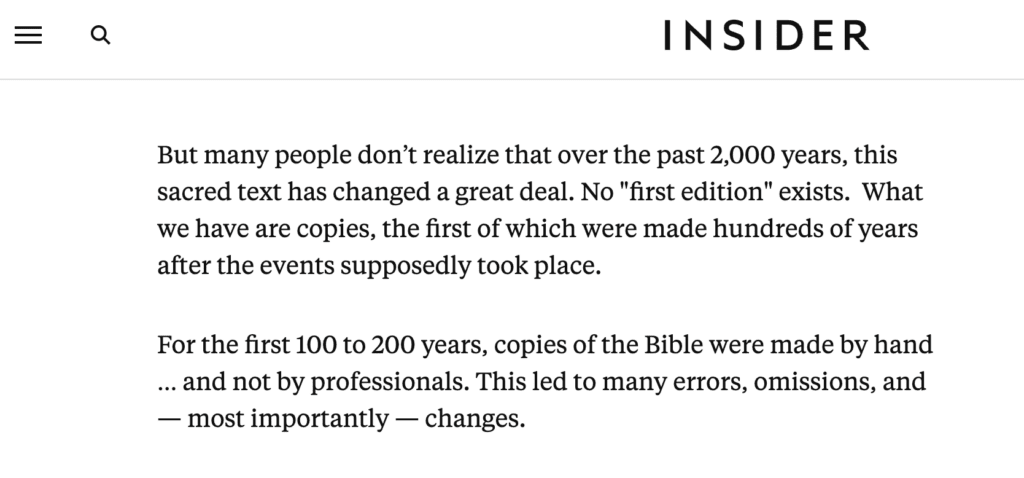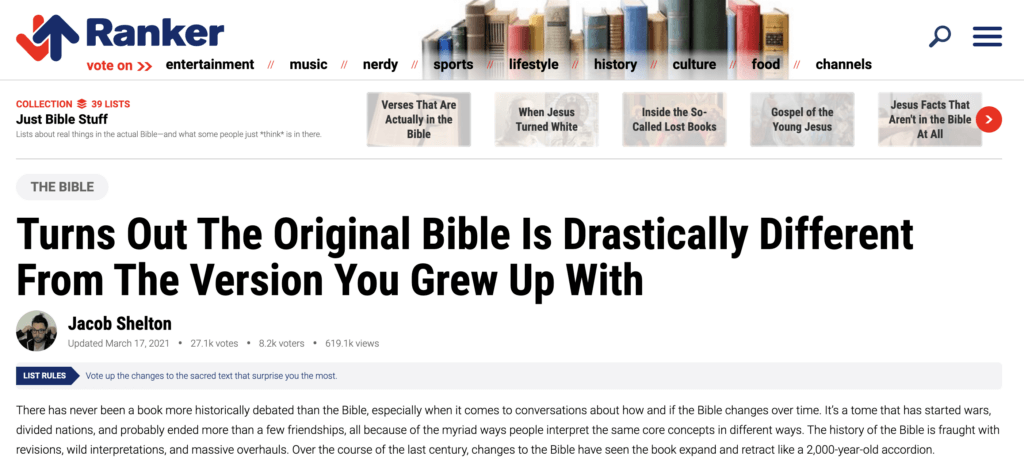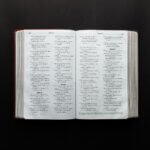Regardless of your faith, it’s likely that you’ve come across the claim that the Bible has been modified or edited over the ages. Simply put, the Bible we read today might diverge significantly from its original scripture.
Another way to phrase the question is, “Is the Bible reliable?”
These kinds of claims are all over the internet.


But that can’t be true, right?
Bible believing Christians typically write these off as wild conspiracies. We’d agree they’re not true, but what evidence do we have that the Bible we read today is the same (or extraordinarily close) to what was originally written in the scriptures?
Thankfully, we do have some evidence.
The Bible Was God-Breathed, but Written By Humans
Before we dive into some helpful evidence that the Bible hasn’t been altered over time, let’s first make sure we’re approaching this question as we should.
We believe the Bible is wholly inspired by God:
All Scripture is God-breathed and is useful for teaching, rebuking, correcting and training in righteousness, so that the servant of God may be thoroughly equipped for every good work.
2 Timothy 3:16-17
Knowing this first of all, that no prophecy of Scripture comes from someone’s own interpretation. For no prophecy was ever produced by the will of man, but men spoke from God as they were carried along by the Holy Spirit.
2 Peter 1:20-21
These scriptures give us confidence that we can approach the Bible as the authoritative Word of God.
But we also have to keep in mind that the Bible was written by human beings in a specific period of time at a specific place. The Bible didn’t float down to us on golden tablets directly from the hand of God Himself.
This means that the Bible is subject to things of Earth. The Bible is subject to the context and language of its original time and place of writing. It’s also worth noting the Bible wasn’t written as one book. It contains lots of different books written at different times by different people throughout history.
Though we believe it to be the literal Word of God, its books were originally written on manuscripts just like any other ancient text of the time. The original scriptures have been subject to changing times, fires, wars, changing popular languages, and the rise and fall of civilizations. If one of the original manuscripts was burned in a fire – it got burned. We lost it.
The Bible was translated and copied over time, could a copyist have made a small spelling mistake in their translation. Yes.
Could God have sent down the scriptures on golden tablets that would forever be preserved in antiquity? Of course. But as He always has, He chose to reveal Himself and tell His story through common, everyday people in specific times and contexts throughout history.
So with that in mind, we have to ask, “If the Bible isn’t 100% the exact same as it was when originally written, is it still the Word of God? Is it still authoritative?” If we view it as only divine, most of us would answer, “No. It’s no longer reliable.” But if we view it through the same lens we view any ancient text, we would say, “Yeah sure. In most cases, a few small changes doesn’t change what I believe about the Scriptures.”
Keep these ideas in mind – we’ll circle back to them. Lets next talk about how the Bible was passed down through generations and preserved over time.
The Bible Did Have Copyists and Editors
So if the Bible didn’t come down to us on invincible golden tablets, how were different books passed down over time? How did we get from the original texts to what we have now? And is there a chance they were changed or altered in between? We’ll look at the books of the Old Testament and New Testament separately.
The Preservation of the Old Testament
Old Testament scripture itself doesn’t give us a clear idea of when the books were assembled into the Bible we use today. But scholars believe the Old Testament canon was closed earlier than 200 BC. They believe the earliest biblical manuscripts were transmitted in the oral tradition – as not everyone had the access or ability to write. But at some point, it was decided the Scriptures had to be written down to ensure their accuracy over time.
The Scriptures were so important to the nation of Israel, that a special class of scholars called Soferim (Hebrew: סוֹפְרִים) developed during the Second Temple period. From about 500 BC to 100 AD, the primary task of these scribes was to preserve Israel’s sacred traditions, which served as the foundation of the Jewish nation. They likely specialized in the biblical manuscripts they transcribed and the topics they wrote about.
The Encyclopedia Britannica says:
Historically, the Soferim are of great importance, not only for having initiated rabbinic studies but also for having fixed the canon of Old Testament Scriptures and, as copyists and editors, for their energetic efforts to safeguard the purity of the original text. The Talmud (the collection of traditions on Jewish religious laws) records 18 changes (tiqqune soferim) that they introduced to preclude misunderstanding of the Scriptures.
Around 200 BC, the Old Testament – the Torah, wisdom books, prophets, and poetry – was translated from Hebrew into Greek giving us what scholars call the Septuagint. In 900 AD, we pieced together a large number of Old Testament manuscripts to form what’s now called the Masoteric texts. These are the two texts used most commonly in modern translations of the OT. More on them later. Decisions were made at this time about how the Bible would be organized.
The Preservation of the New Testament
We believe that all of the New Testament books were written between the death of Jesus (30 AD) and the death of Paul (around 95 AD). Some scholars like John A.T. Robinson believe all the books of the New Testament could have been completed by 70 AD, only 40 years after Christ’s death and resurrection.
After their original writings, the New Testament books were copied by different early church leaders as they were circulated around. It’s possible thousands of copies existed of different New Testament books among the early churches across Europe and Asia Minor.
Today, we have thousands of New Testament manuscripts with the vast majority being nearly identical. It is true that some contain differences, but with so many manuscripts to evaluate, it’s not difficult to determine what was originally intended. The differences we do see are minor.
The Bible Has Been Accurately Preserved Over Time
So after thousands of years and a bunch of copying and pasting of OT and NT books, isn’t it likely the Bible was changed and altered? To a tiny, minuscule degree – yes, potentially. But we have a good bit of evidence that says it was providentially and accurately preserved – from the longest chapter to the shortest chapter.
The Dead Sea Scrolls (Authenticity of the Old Testament Bible)
From 1947 to 1956 about 930 scrolls were found in 11 desert caves near Qumran, a site about 12½ miles southeast of Jerusalem. The discovery had massive implications for the Bible’s reliability and authority. The Dead Sea Scrolls contained all or part of every Old Testament book, whose writings date back to around 300 BC. Compared to the texts we rely on for translation today, these Old Testament portions align remarkably.
There are only a handful of passages found in the Dead Sea Scrolls that are notably different from the Hebrew manuscripts we rely on for translation today.
That’s wild – it means that in the 1,000 years from initially recording most books of the Old Testament – despite all of the copying and pasting – the texts were somewhere around 99% similar. The few differences were either subtle grammatical differences, spelling differences, or really unusual instances that didn’t hold much bearing on the overall message of the scripture.
So we can say with confidence that the Old Testament has been copied and transmitted over time with insane accuracy. It would not be a stretch to say that the original Hebrew Bible Jesus read and referenced is the same we read today.
It’s also worth noting that we’ve got the right books of the Old Testament included in our Bible. For example, The Book of Enoch was long included in the OT, but due to concerns about its authorship and some of its claims, it didn’t make the cut.
The Reliability of the New Testament
Now let’s talk about the reliability of the New Testament.
We actually still have a lot of original manuscripts of New Testament books dating back to as early as 125 AD. We have somewhere in the ballpark of 5,000 Greek manuscripts and at least 10,000 manuscripts in other languages. What exactly does that mean?
Let’s say Paul wrote the letter of Galatians and sent it to their church. Someone in their church likely would have copied it word for word right away before sending it on to another nearby church. They would have then made a few copies – let’s say 2 or 3 to keep for themselves and 1 or 2 to pass along. So as these books of the NT circulated, more and more manuscripts were created.
As we already asked, doesn’t this leave tons of room for changes to be made? Sure, it’s possible.
But much like the Dead Sea Scrolls, among these thousands of manuscripts, the differences are minimal. And of the notable differences, because we have thousands of manuscripts to look at, it’s easy to determine the original intent. For example, let’s say we notice 20 manuscripts include a random paragraph that doesn’t seem to fit with the flow of one of the books. We see in 2500 other manuscripts that this story isn’t included, we can be confident it was added (whether by mistake or on purpose) and leave it out of our modern translations.
The Bible Compared to Other Ancient Texts
Some people might say, “Okay cool – lots of manuscripts from the New Testament and the Dead Sea Scrolls seems pretty legit. But our manuscripts depicting the life of Jesus came a hundred years after his life? How could that be reliable?”
It’s important to ask here, “Compared to what?” Is 100 years between original writing and what we have today a long gap? Is that enough time for the Bible to be changed, altered, or tampered with?
Let’s look at Plato’s The Republic, a classic piece of literature that most people don’t debate the authenticity of. It was originally written around 400 BC. The earliest copy we have is from 900 AD, and we only have around 10 copies.
Compare that to the New Testament: It was written between 50-100 AD. We have copies of portions as far back as 114 AD and we have a copy of the entire New Testament from 325 AD. And there are somewhere around 5,000 copies.
So yeah, 225 years between the writing and the complete New Testament seems long, but it’s a heck of a lot closer than 1,000 years.
Here’s some data on other well-known ancient texts in comparison to the New Testament:
| Book | Date Written | Earliest Copy | Time Gap | # of Copies |
|---|---|---|---|---|
| Homer's Illiad | 800 BC | 400 BC | 400 years | 643 |
| Herodotus' History | ~ 450 BC | 900 AD | 1,350 years | 8 |
| Thucydides' History | ~ 450 BC | 900 AD | 1,350 years | 8 |
| Plato's Republic | 400 BC | 900 AD | 1,300 years | 7 |
| Caesar's Gaelic Wars | ~ 50 BC | 900 AD | 950 years | 10 |
| New Testament | 50-100 AD | 114 AD (portions) 325 AD (complete NT) | 50 - 250 years | 5,000+ |
The Bible Has Not Been Changed or Altered Over Time
There’s ample evidence that suggests the Bible is actually one of the most authentic and reliable ancient texts we have. It’s been preserved by the faithful work of the Church through the providence of God. You can rest assured the version of the Bible you read was translated from a sound, well-preserved manuscript of the Holy Bible. You can also buy a study Bible – many of which include helpful notes about how certain books have been preserved over time.





